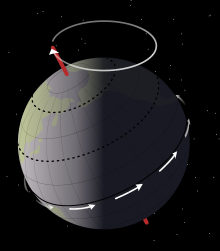অক্ষীয় অয়নচলন: সংশোধিত সংস্করণের মধ্যে পার্থক্য
বিষয়বস্তু বিয়োগ হয়েছে বিষয়বস্তু যোগ হয়েছে
অজয় মন্ডল (আলোচনা | অবদান) |
অজয় মন্ডল (আলোচনা | অবদান) অজয় মন্ডল (আলাপ)-এর সম্পাদিত 3196807 নম্বর সংশোধনটি বাতিল করা হয়েছে ট্যাগ: পূর্বাবস্থায় ফেরত |
||
| ১৮ নং লাইন: | ১৮ নং লাইন: | ||
=== মেরু ও বিষুব স্থানান্তরণ === |
=== মেরু ও বিষুব স্থানান্তরণ === |
||
==Effects== |
|||
[[File:Earth axial precession.svg|thumb|300px|The coincidence of the annual cycles of the apses (closest and further approach to the sun) and calendar dates (with seasons noted) at four equally spaced stages of precessionary 26,000-year-cycle. The season dates are those in the north. The tilt of Earth's axis and the eccentricity of its orbit are exaggerated. Approximate estimates. Effects of weak planetary precession on the stages shown are ignored.]] |
|||
The precession of the Earth's axis has a number of observable effects. First, the positions of the south and north [[celestial pole]]s appear to move in circles against the space-fixed backdrop of stars, completing one circuit in approximately 26,000 years. Thus, while today the star [[Polaris]] lies approximately at the north celestial pole, this will change over time, and other stars will become the "[[pole star|north star]]".<ref name="Astro 101"/> In approximately 3200 years, the star [[Gamma Cephei]] in the Cepheus constellation will succeed Polaris for this position. The south celestial pole currently lacks a bright star to mark its position, but over time precession also will cause bright stars to become [[South Star|south stars]]. As the celestial poles shift, there is a corresponding gradual shift in the apparent orientation of the whole star field, as viewed from a particular position on Earth. |
|||
Secondly, the position of the Earth in its orbit around the Sun at the [[solstice]]s, [[equinox]]es, or other time defined relative to the seasons, slowly changes.<ref name="Astro 101"/> For example, suppose that the Earth's orbital position is marked at the summer solstice, when the Earth's [[axial tilt]] is pointing directly toward the Sun. One full orbit later, when the Sun has returned to the same apparent position relative to the background stars, the Earth's axial tilt is not now directly toward the Sun: because of the effects of precession, it is a little way "beyond" this. In other words, the solstice occurred a little ''earlier'' in the orbit. Thus, the [[tropical year]], measuring the cycle of seasons (for example, the time from solstice to solstice, or equinox to equinox), is about 20 minutes shorter than the [[sidereal year]], which is measured by the Sun's apparent position relative to the stars. After about 26 000 years the difference amounts to a full year, so the positions of the seasons relative to the orbit are "back where they started". (Other effects also slowly change the shape and orientation of the Earth's orbit, and these, in combination with precession, create various cycles of differing periods; see also [[Milankovitch cycles]]. The magnitude of the Earth's tilt, as opposed to merely its orientation, also changes slowly over time, but this effect is not attributed directly to precession.) |
|||
For identical reasons, the apparent position of the Sun relative to the backdrop of the stars at some seasonally fixed time slowly regresses a full 360° through all twelve traditional constellations of the [[zodiac]], at the rate of about 50.3 [[Arcsecond|seconds of arc]] per year, or 1 degree every 71.6 years. |
|||
At present, the rate of precession corresponds to a period of 25,772 years, but the rate itself varies somewhat with time (see [[#Values|Values]] below), so one cannot say that in exactly 25,772 years the earth's axis will be back to where it is now. |
|||
For further details, see [[#Changing pole stars|Changing pole stars]] and [[#Polar shift and equinoxes shift|Polar shift and equinoxes shift]], below. |
|||
[[চিত্র:Outside view of precession.jpg|left|thumb|350px|খগোলকের 'বাইরে' থেকে '''অয়নচলন গতি''' যেমন দেখায়]] |
[[চিত্র:Outside view of precession.jpg|left|thumb|350px|খগোলকের 'বাইরে' থেকে '''অয়নচলন গতি''' যেমন দেখায়]] |
||
[[চিত্র:Precession animation small new.gif|right|thumb|350px|২৬,০০০ বছরব্যাপী অয়নচলন-চক্রকে পৃথিবীর কাছ থেকে এমনটাই দেখায় । বর্তমান উত্তর [[মেরুতারা]] - [[ধ্রুবতারা]] ([[Alpha UMi|Polaris]]) (উপরে) । প্রায় ৮,০০০ বছরে এ স্থানটি নেবে উজ্জ্বল [[তারা]] [[দানব (তারা)|দানব]] ([[Alpha Cygni|Deneb]]) (বামে) , আর প্রায় ১২,০০০ বছরে [[অভিজিৎ (তারা)|অভিজিৎ]] ([[Alpha Lyra|Vega]]) (বামমধ্য) । এখানে পৃথিবীর আবর্তনকে পরিমাপক-রেখায় দেখানো হয়নি - এ সময়কালে পৃথিবী ৯,০০০,০০০ বারেরও বেশিবার স্বাবর্তিত হবে।]] |
[[চিত্র:Precession animation small new.gif|right|thumb|350px|২৬,০০০ বছরব্যাপী অয়নচলন-চক্রকে পৃথিবীর কাছ থেকে এমনটাই দেখায় । বর্তমান উত্তর [[মেরুতারা]] - [[ধ্রুবতারা]] ([[Alpha UMi|Polaris]]) (উপরে) । প্রায় ৮,০০০ বছরে এ স্থানটি নেবে উজ্জ্বল [[তারা]] [[দানব (তারা)|দানব]] ([[Alpha Cygni|Deneb]]) (বামে) , আর প্রায় ১২,০০০ বছরে [[অভিজিৎ (তারা)|অভিজিৎ]] ([[Alpha Lyra|Vega]]) (বামমধ্য) । এখানে পৃথিবীর আবর্তনকে পরিমাপক-রেখায় দেখানো হয়নি - এ সময়কালে পৃথিবী ৯,০০০,০০০ বারেরও বেশিবার স্বাবর্তিত হবে।]] |
||
১৫:২৮, ১৮ নভেম্বর ২০১৮ তারিখে সংশোধিত সংস্করণ

জ্যোতির্বিজ্ঞানে অক্ষীয় অয়নচলন হচ্ছে কোনো জ্যোতির্বস্তুর আবর্তনশীল অক্ষকে ঘিরে অভিকর্ষ-প্রভাবিত মন্থর ও অবিরল দোলিত চলন বা স্থান-পরিবর্তন ।
অক্ষীয় অয়নচলন বলতে সুনির্দিষ্টভাবে পৃথিবীর আবর্তন-অক্ষের অবিরল দোলিত চলনকেই বুঝায় যা , হেলেদুলে-ঘূর্ণায়মান একটি লাটিমের মতো , প্রায় ২৬,০০০ বছরব্যাপী এক চক্রে শীর্ষ-মিলিত এক জোড়া কোণ তৈরী করে ।
সাধারণত অয়নচলন বলতে চলনগতির এ মুখ্যাংশকেই বুঝায় ; কারণ পৃথিবীর অক্ষের সমরেখনে অন্যান্য পরিবর্তন , যেমন : অক্ষচলন ও মেরুচলন , মাত্রায় ক্ষীণ ।
অক্ষীয় অয়নচলনের ঘটনাদি
পরিবর্তনীয় মেরুতারা


পরিবর্তনীয় মেরুতারা হলো অয়নচলনের ক্রম । বর্তমানে মেরু থেকে ১ অংশ (degee) দূরে থেকেও প্রায় ২.১ ঔজ্জ্বল্য নিয়ে উত্তরাকাশের ধ্রুবতারা (Polaris) খগোলকীয় উত্তর মেরুকে বেশ সুস্পষ্টভাবেই চিহ্নিত করছে । [২]
মেরু ও বিষুব স্থানান্তরণ


আরও দেখুন
পাদটীকা
- ↑ Hohenkerk, C.Y., Yallop, B.D., Smith, C.A., & Sinclair, A.T. "Celestial Reference Systems" in Seidelmann, P.K. (ed.) Explanatory Supplement to the Astronomical Almanac. Sausalito: University Science Books. p. 99.
- ↑ van Leeuwen, F. (২০০৭)। "HIP 11767"। Hipparcos, the New Reduction। সংগ্রহের তারিখ ২০১১-০৩-০১।
